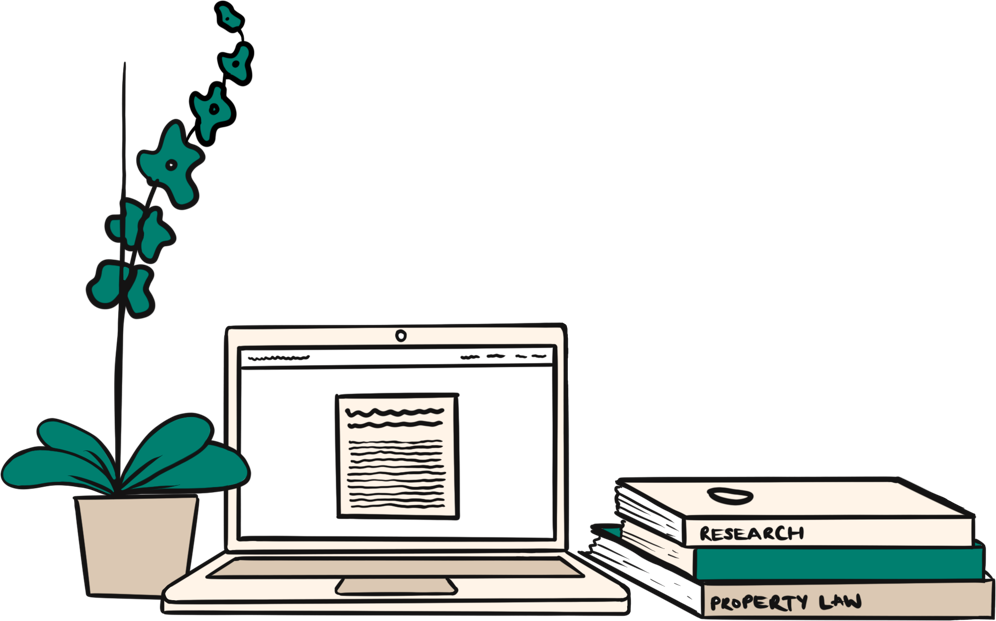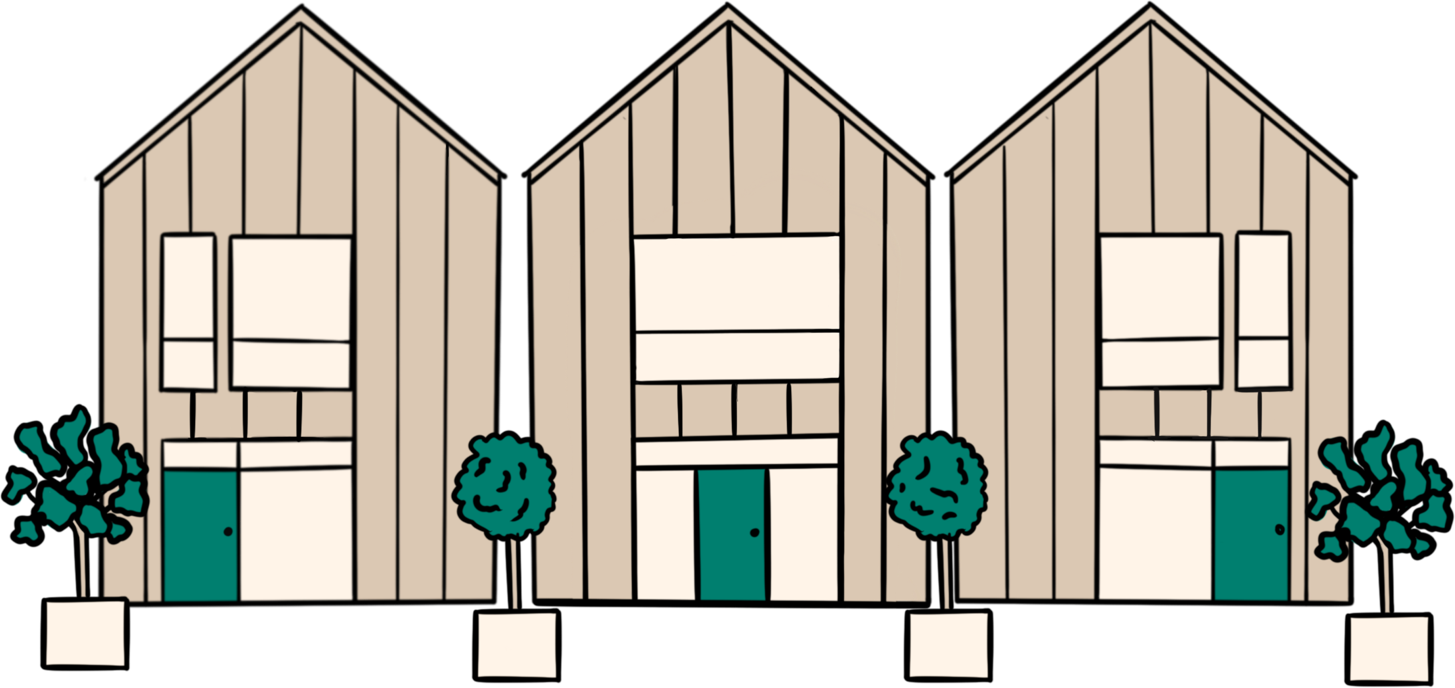Tell us about your move - are you buying, selling, or both?

Key takeaways
- A mortgage lets you purchase property by borrowing money from a lender, secured against the property itself
- The larger your deposit, the better mortgage rates and deals you'll typically be offered
- Fixed-rate mortgages maintain the same payments for a set period, while variable rates can change with market conditions
- You can apply directly to lenders or use a mortgage broker who has access to multiple lenders
- Self-employed applicants typically need 2-3 years of accounts or tax returns to prove their income
Looking to get on the property ladder as a first-time buyer? Or maybe it’s been a while since you moved, and you need your memory refreshed. It’s completely normal to feel a little confused or overwhelmed when it comes to mortgages. From fixed or variable rates to going directly to lenders or using a broker, there’s a lot to consider.
But we’re going to break it all down for you in a simplistic way, here’s a complete guide to mortgages.
What is a mortgage?
Before diving into the nitty gritty of mortgages, let's first get a grip on what the definition of a mortgage is.
At its core, a mortgage is simply a loan that allows you to purchase a property without having to pay the full amount upfront. Instead of paying out the entire cost, you borrow a portion of the money from a lender and then gradually pay it back over an agreed period, along with some interest. In return, the lender needs something to rely on in case you don’t pay the full amount back.
Think of it like this, the lender is essentially giving you credit to buy property, and to protect their investment, the mortgage is secured against the home itself. While it might sound a bit daunting, this just means that if you fail to make repayments, the lender has the right to take possession of the property to recoup their money.
How do mortgages work?
We know there's a lot to get your head around when it comes to mortgages, but don't sweat it - we'll break it all down in a way that makes total sense. To start, let's talk about some of the key components you'll encounter:
Deposit
You’ll need to put down an initial deposit, typically between 5-20% of the property value upfront. The more you can put down, the smaller the mortgage loan you’ll need.
Mortgage loan
The lender will then provide you with the remaining cost of your property, minus your deposit amount. This is the sum that you’ll repay over time.
Interest rate
In addition to repaying the amount you borrow, you’ll also pay interest to the lender as a fee for borrowing the money. Mortgage interest rates can be fixed for a set period, track the Bank of England base rate, or be the lender’s standard variable rate (more on this later).
Repayment term
Mortgages typically run for 25-30 years but can be shorter or longer depending on your preferences and what you can afford. During your repayment term, your monthly payments go towards just the interest or both the loan and the interest.
Equity build-up
As you chip away at your payments, you gain more equity by reducing the mortgage debt amount owed to the lender. At the end of your mortgage term, you fully own the property outright (provided you’re not on an interest-only agreement).
Where do I find a mortgage?
When it comes to securing a mortgage, you have two main options, you can go directly to the lender, or use the services of a mortgage broker.
Going directly to lenders
When you go directly to a lender for your mortgage, you’re essentially cutting out the middleman and dealing one-on-one with a specific bank, building society, or other mortgage provider.
The process is pretty straightforward. You’ll do a bit of homework, checking out the various mortgage products and rates each lender has on offer. Once you’ve found one that seems like a good fit, you’ll kick off the official application process directly with them.
You’ll need to provide some details when applying, like income, expenses, assets, credit profile and property information. The lender will assess your application based on their own lending criteria to determine if you qualify and what rates/terms they can offer.
If approved, you’ll get a mortgage offer to review and be asked to complete the full application with your chosen lender.

Pros of going direct:
- Avoid broker fees – You don’t have to pay any arrangement/broker fees by going direct.
- Direct communication – You deal directly with the lender’s staff throughout.
- Exclusive deals – Some lenders may offer exclusive rates only available directly.
Cons of going direct:
- Limited options – You only have access to your chosen lender mortgage range.
- No negotiation – Less opportunity to negotiate better rates/terms.
- No expert advice – You’ll miss out on guidance an experienced broker provides.
- Legwork involved – You must do all the research and paperwork yourself.

Using a mortgage broker
Working with a mortgage broker is like having your own personal mortgage matchmaker. These independent professionals have access to a wide range of lenders and products, giving them a broad view of the market.
During your initial meeting, your broker will get to know your homebuying goals inside and out – your finances, must-haves, and anything else. They’ll need you to provide some documentation like payslips, bank statements and other documents to assess your affordability. With this information, they’ll scour through all the available options to hand-pick the ones that could be a perfect fit for you.
They’ll also handle the mortgage application process entirely on your behalf with your chosen lender.
Benefits of using a broker:
- Wide market access – Brokers can search a wealth of mortgage products.
- Tailored advice – They recommend ideal mortgages for your specific needs.
- Knowledge and experience – Mortgage brokers are experts in their field.
- Time and effort saved – They manage the entire search and application process.
Disadvantages of using a broker
- Broker fees – You may need to pay broker fees.
- Lender restrictions – Not all lenders work with brokers, meaning that you could miss out on good deals by not going direct.
- Restricted communication – You miss out on the chance to build a relationship with your lender as your broker handles all communication.
- Lender bias – some brokers may lean towards certain lenders because of their relationship with them, try to make sure you always come first.
Have I got enough deposit?
We get it – saving up a sizable deposit can feel like an uphill battle when you’re determined to finally get those house keys in hand. But having a decent chunk of change ready to go plays a huge role in not just qualifying for a mortgage but getting the best rates too.
If you’re a first-time buyer, that deposit is going to need to come from your own savings. OR maybe you’re being gifted some funds through a gifted deposit. We have a full guide explaining gifted deposits here.
For those who already own a property and need to simultaneously buy and sell a home, the equity that you’ve already built up in your current home could put you in a good position to put down a large deposit, especially if the value of the home has increased since your purchased it. We break down selling your home here.

How much deposit do I need?
Let’s talk deposit sizes and why aiming a bit higher can really pay off down the line. In some cases, lenders may approve you with just a 5% deposit. But by putting down somewhere between 10% and 20% of the purchase price, you’ll be in a much stronger position. The higher deposit doesn’t just mean you borrow less, but it’ll also get you access to better rates and terms from lenders.
For example, let’s say the home you’ve got your eye on is listed at £200,000. If you can muster up a 15% deposit, that’s £30,000. That means you’d need to borrow the remaining 85% or £170,000 from your lender to cover the rest. Resulting in lower monthly payments and better rates and terms when compared to a 5% deposit.
It’s also a good idea to get a Mortgage in Principle (MIP) before house hunting. A MIP will give a realistic estimate of how much a lender would be willing to let you borrow based on your finances. Sure, it’s not 100% set in stone, but it provides a solid ballpark to work with.
What type of mortgage do I need?
With so many mortgage options out there, it can feel a little like a maze when you first start looking. It’s important to take the time to find the right one for you. Here’s some mortgage options you need to consider:
First, decide on the type of mortgage you need
When it comes to choosing between repayment and interest-only mortgage options, the repayment option is usually the more popular route. Unless you have a compelling reason to go interest-only.
With a repayment mortgage, your monthly payments go towards two things – paying off the interest charged on the loan and paying down the actual loan amount itself. So over time, the total amount you owe gets smaller.
An interest-only mortgage is different. Your monthly payments only cover the interest charges but don’t actually reduce the original loan amount at all.
Naturally, repayment mortgages cost more month on month, as you’re paying off both your debt and the interest. But at the end of your payment term, you’ll own the property outright, and be free of mortgage debt.
Then you need to look at what rate you want
Most deals fall into two categories, fixed or variable rate.
Fixed-rate mortgages
A fixed-rate mortgage does what it says, it stays fixed. So, regardless of what happens to interest rates, with a fixed mortgage repayments will remain the same for the period you agreed to fix for. This could be two, three, five years or more.
Fixed-rate mortgages are a popular type of mortgage because of their benefits, including:
- Payment certainty: The biggest advantage is knowing exactly what your monthly mortgage payments will be during your fixed period (usually 2-5 years). This allows you to budget more easily and avoid any nasty payment shocks if interest rates rise.
- Protection from raised rates: With a fixed rate, you are locked into that interest rate for the set period regardless of whether the Bank of England raises the base rate.
- Potential savings: If interest rates do happen to rise substantially, you could potentially save a fair amount compared to a variable-rate mortgage.
- Time to plan: Knowing when the fixed period ends allows you time to plan your options for remortgaging or reverting to the lender's standard variable rate when it expires.
Variable rate mortgages
A variable rate mortgage is opposite to a fixed rate, meaning that it can fluctuate with interest rates. The rate that you pay is not fixed, rather it varies or adjusts periodically based on market conditions and the lender’s discretion.
There are different types of variable-rate mortgages:
Tracker mortgage
Tracker mortgages are a variable rate deal that ‘tracks’ a fixed economic indicator (typically the Bank of England’s base rate). If the base rate goes up by 1%, so will your mortgage repayments. Similarly, if it goes down, so will your repayments.
Some trackers will come with a ‘collar’, which means that the rate can only fall to a set level. This would mean that if the base rate were to sink, your payments may not follow suit exactly.
Standard variable rates (SVRs)
Each lender has an SVR (it may have a slightly different name) which often follows the Bank of England’s base rate, but not exactly. Each lender can set their own SVR to whatever they want. SVRs don’t change often, and they’re not directly linked to the base rate but are often affected by it.
Let’s say that if the base rate went up by 0.3%, lenders would likely also raise their SVR by at least that much, if not more. This means your monthly payments would increase by the amount set. Whereas if the base rate dropped by 0.3%, they may only drop their SVR by 0.2%, or they could decide to not decrease it at all.
SVRs can be much higher than the base rate and will vary between lenders. Often not available to new customers, it’s the rate where borrowers go when their fixed, tracker or other deal has expired.
Discount rates
Discount rate mortgages are variable-rate deals that charge your lender’s SVR minus a fixed margin.
For example, if your lender’s SVR is 7% and your deal charges minus 3%, you’ll pay a rate of 4%.
Be aware that this is still a variable rate, if the lender’s SVR goes up, so will your monthly payments.
The mortgage deals typically run for a short period of two or three years.
Variable-rate mortgages could be the right choice in certain circumstances. While they provide more flexibility and the potential for savings, they also come with increased uncertainty and risk. Here’s a breakdown of the main pros and cons to consider:
On the plus side, variable rates:
- Typically, lower initial interest rates than fixed rates
- No early repayment charges, so more flexibility
- Potential to benefit from future interest rate decreases
- Can be a good option if you expect to move or remortgage again soon
But the downsides include:
- Uncertainty with interest rates could end up costing you a lot more
- Budgeting is more difficult with unpredictable payment amounts
- Less payment security/stability compared to fixed-rate mortgages
Getting a mortgage if you’re self-employed
If you’re self-employed or would struggle to prove your long-term income – maybe you’ve worked abroad, or you are on a temporary contract – then getting a mortgage could be a little tricky. You’ll need concrete proof of your income, which can sometimes be tough in these situations.
What do I need to prove?
You’ll basically need to prove that you can afford mortgage repayments. This is typically done in one of two ways:
- Business accounts: You’ll likely be asked to show three years of accounts. They need to be signed off by a chartered or certified accountant.
- Tax returns: If you’re unable to show business accounts, then you’ll need to show two or three years of tax returns.
It’s crucial to remember that lenders will be assessing your income based on profits, not your total turnover. There is a temptation to minimise declared profits to reduce taxes, but just be aware that this approach could ultimately make qualifying for a mortgage tough (it’s also illegal).
If you’re brand new to the self-employed game, the reality is securing a mortgage may prove quite challenging at first. Lenders typically want to see a solid track record of at least a couple of years’ worth of steady financials before extending an offer.
Enlisting the help of an experienced mortgage broker in these circumstances could be a game-changer. They’ll have experience working with self-employed individuals and could give you a better chance of securing a mortgage that suits you.
Although getting a mortgage as someone self-employed is tougher, don’t let that discourage you. It’s totally doable with the right preparation and guidance.
Don’t forget to factor in other costs
Buying a house involves various costs beyond the deposit and mortgage payments. You also need to consider things like:
- Conveyancing fees
- Disbursements
- Stamp Duty Land Tax
- Mortgage valuations
- Mortgage brokers
- Building insurance
- Removal costs
- And more…
Read our full guide on the costs of buying a house and moving here for a complete breakdown.
A step-by-step guide to getting a mortgage
Getting a mortgage and purchasing a property may feel like a daunting task but breaking it down into clear steps can make it much more manageable. Here’s a walkthrough of what to expect.
Get your finances in order
Before applying, get organised with documents proving your income, expenditures, credit reports, ID, and addresses. Lenders will want to see payslips, bank statements, bills and more to verify your financial standing.
And of course, it goes without saying but don’t forget to save up for that all-important deposit.
Get a mortgage in principle
With your documentation and deposit ready, you can begin to approach lenders for a mortgage in principle. This will give you an estimate of what you could potentially borrow based on your income, debts, deposit, and credit profile.
It’s time to find your property
Armed with a mortgage in principle, you’ll have a good idea of what your maximum purchase budget is to go house hunting. Remember to factor in those other costs that you’re going to need to consider. Follow this guide on how to make an offer on a house.
Get a mortgage offer
Once you’ve had an offer accepted, go back to your chosen lender, and submit a full mortgage application. You’ll need to include some more information for the full application, including the property details. The lender will conduct a valuation and additional credit checks.
Hire a conveyancer
You’ll need a solicitor or licensed conveyancer to handle the legal paperwork and checks around your property purchase. They manage the legal side of your property purchase, including local searches, draft contracts, communication with the seller’s conveyancer and more. Read our full guide to conveyancing here.
Mortgage finalisation
Now that you’ve gone over your mortgage offer document with a fine-tooth comb, you need to either accept or reject the mortgage offer. We’re guessing that if you’ve gotten this far – lining up your property, powering through the mortgage application process, and even choosing a conveyancer, your mind is pretty made up to accept this offer.
Exchange contracts
With the mortgage secured, your conveyancer will coordinate an agreed date to both exchange contracts and complete. When you exchange contracts the property transaction becomes legally binding, as a buyer, backing out after this point will mean you lose your exchange deposit (usually 10% of the property value).
Completion day
On completion day, your lender will send your conveyancer the remainder of the purchase funds. Your conveyancer will then transfer them to the seller’s conveyancer and once cleared, the keys will be released to you.
And that’s it! Congratulations on navigating the mortgage maze and successfully purchasing your property.
Frequently asked questions
What is the minimum deposit required for a mortgage?
When it comes to the minimum deposit required for a mortgage in the UK, the standard amount is typically 5% of the property purchase price. However, the bigger the deposit you can put down, the better.
With a 5% deposit, you’ll be taking out a 95% loan-to-value mortgage. While possible, these high loan-to-value mortgages can be harder to qualify for and often come with higher interest rates and lender fees.
The bigger your deposit contribution, the smaller the mortgage loan you’ll need from the lender. This makes you a lower lending risk in the eyes of mortgage providers and will also unlock access to better mortgage rates and terms.
How does the mortgage term length affect my monthly payments?
The mortgage length you choose will have a direct impact on what your monthly mortgage payments will look like. The longer your repayment term, the lower your monthly costs will be - but the more total interest you’ll pay over the full life of the loan.
In the UK, most lenders offer mortgage terms ranging from 25 to 35 years. Shorter terms are available, meaning that you’d have higher monthly payments, but you’ll pay less total interest and become mortgage-free much sooner.
What documentation do I need to provide for a mortgage?
Before applying for a mortgage, it’d be useful to have several documents to hand as well as having a good understanding of your finances to help prepare you for getting a mortgage.
Here’s what’s good to prepare for:
- Check your credit report: The better your credit score, the more reliable you are to pay back the mortgage and keep up with monthly payments.
- Proof of ID: A passport or driving licence are the most used documents for proof of ID, make sure to have one of these handy.
- Proof of address: You’re going to need to prove you live at your address, this can be in the form of council tax bills, utility bills, bank statements etc. that are dated within the last three months.
- Evidence of deposit: Lenders will want to know where your mortgage deposit is coming from. If it’s from your savings, you’ll need to prove it via bank statements. And if you’re being gifted money the giftor will need to provide a signed letter.
- Proof of income: You’ll be asked to show the last three months of payslips. And if you’ve changed your job or salary, you need to able to provide proof. You’ll also need to provide the previous three months of bank statements, this will need to be the same account your salary is paid into.
- Proof of expenses: Lenders won’t only check income, they’ll also check expenditures and if you have any financial commitment that may affect how much you can afford to pay back.

Need conveyancing without the confusion?
At Eden, we’re dedicated to transparency, and making sure we manage all of the legal stuff so you can focus on what truly matters.
You’ll get your own dedicated property lawyer who you can contact whenever you need. You’ll also get access to our 24/7 online portal, ensuring you’re updated every step of the way.

